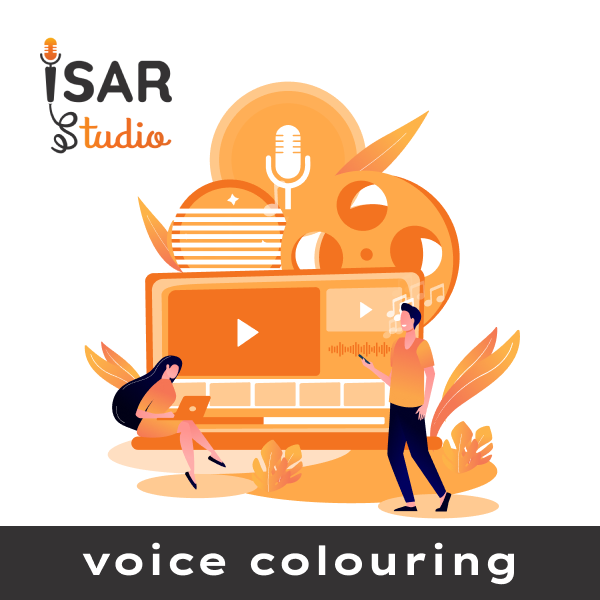introduction to colorization
Voice coloring: It is one of the branches of voiceover, and it is the art of transforming the sound into a distinctive artistic painting, where voice commentary is an important and essential way to convey information, ideas, and feelings effectively, and this requires the use of different techniques to achieve the best results, and one of the most important of these techniques is voice coloring.
This article aims to clarify the concept of vocal coloring, and how it can be effectively mastered to achieve the best results in the audio production process. Examples and explanations will be used to facilitate a better understanding of this concept.
What is Voice coloring?
The sound coloring is like coloring the graphics. The colors add aesthetics and highlight the details in the image, and the viewer is dazzled by them.
For example, warm colors such as red and yellow can be used to enhance a sense of enthusiasm and vitality, while cool colors such as blue and green can be used to promote calm and harmony.
This applies to vocal coloring, but the means differ, as the voice commentator uses the tones of his voice and changes in sound and rhythm according to the subject and quality of the text, to enhance the meaning and feeling and make the text more attractive and persuasive to the audience.
What is Voice coloration used for?
From the foregoing, we conclude that vocal coloring is used to enhance the text, focus on important points, direct the audience’s attention to key information, and highlight different emotions such as happiness, sadness, excitement, suspense, anger, and others.
Although vocal coloring is an effective tool that helps improve the quality of audio production and increase the attractiveness of the products and services provided, its mastery requires comprehensive knowledge of all its elements.
What are the elements of vocal coloring?
Vocal coloring elements are the basic components that can be used to enhance and improve vocal performance, and include the following:
General character: that is, specifying the type of text, whether it is advertising, documentary, or poetic text… because each type has a method of performance that suits it.
For example, in car advertisements, voice coloring is used to highlight the speed and high performance of the car. The engine can be heard revving up and the commentator using an uplifting tone of voice to motivate the audience.
Vocal tone: It is the general feeling expressed by the speaker in speech. The tone of voice includes the meaning and feelings that the voiceover wants to convey to the audience and the range of high and low of the voice.
For example, if the text expresses enthusiasm or energy, the voice actor may raise the pitch to make his voice louder, more intense, and faster, but if the script writer wants to convey a calm or romantic message, the voiceover may use a low, calm tone of voice and slower timing of speech .
Speed: The speed may increase in the exciting and suspenseful parts, and decrease in the calm and contemplative parts. For example, in a commercial advertisement for cars, the performance can be fast and full of enthusiasm to indicate the speed of the car. On the other hand, the voice-over can be slow and quiet in An advertisement for a life insurance company, to communicate confidence, comfort and safety to the listener.
Pauses: Refers to pausing for a temporary moment in speech for the purpose of achieving the appropriate effect and conveying the meaning correctly.
For example, long pauses can be used to indicate the end of a paragraph or a sentence, while short pauses can be used to clarify or reinforce a specific part of the text.
Furthermore, pauses help clarify and emphasize the meaning, and give the listener a chance to rest and think. Pauses can be used effectively to find an appropriate balance between tone and speed.
Perhaps you still find it difficult to use the appropriate vocal coloring after you get to know its elements. I will give you some tips that can be followed to master this skill.
Ways to use voice coloring:
Auditory Feed: Create an audio library in your memory Listen to different audio samples by professional voiceovers and analyze how they use voice colouring.
Work on pronunciation and breathing skills: focus on practicing the correct pronunciation of letters and words and learning how to control breathing properly.
Work on improving the ability to express: Try to improve your ability to express feelings and thoughts clearly and understandably, by interacting through your body language to communicate the sincere feeling.
Listen to Feedback and Improve: Listen to other people’s feedback and try to improve your own vocal coloring technique based on that.
After studying vocal coloring, it can be said that it is an essential skill that must be mastered to improve the quality of voice commentary and make it more interesting, without which the commentator falls into vocal monotony. To master this skill, it is important to follow some practical tips and periodic exercises.
Prepared by: İbrahim Zaraa, voiceover manager at ISAR Group
